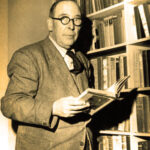
Bible Study Helps: Hebrews and James
After the four gospels, the book of Acts, and the thirteen Pauline epistles, we come to the final nine books of the New Testament. The first two of these are Hebrews and James. Both are very important inclusions in the NT, and both deserve careful reading and study. Let me look at each in turn.
Hebrews
Debate over authorship of this book has never been satisfactorily resolved, so we can only work on other matters, such as a possible date of when it was written. That too is unclear, but a mid-60s date may be our best estimate. It seems fairly likely it was penned before the fall of Jerusalem and the destruction of the temple in AD 70.
 Recipients appear to be Jewish Christians in Rome, and the main theme is the need to stand strong in Christ – the final and supreme revelation of God – and not revert to their pre-Christian Jewish faith. Jesus is pre-eminent over the angels, over the Mosaic law, and over the Old Testament priesthood and sacrificial system.
Recipients appear to be Jewish Christians in Rome, and the main theme is the need to stand strong in Christ – the final and supreme revelation of God – and not revert to their pre-Christian Jewish faith. Jesus is pre-eminent over the angels, over the Mosaic law, and over the Old Testament priesthood and sacrificial system.
Encouragements to continue in the faith and not give up are found throughout the book, including the various warning passages (Heb. 2:14; 3:7-4:13; 5:11-6:12; 10:19-39; and 12:1-29). These strong warnings have been understood in various ways. For a collection of viewpoints on this, see Four Views on the Warning Passages in Hebrews edited by Herbert Bateman (Kregel, 2007).
As George Guthrie says, “The writer of Hebrews is a biblical theologian of the first order. Yet, he brings his theology to bear in service of a critical pastoral need, struggling to help friends in danger of defecting from Christian commitment. In writing Hebrews his first concern is to present a dynamic, motivational, relational appeal, not a cold theological treatise.”
F. F. Bruce says this about Hebrews and the gospel:
The purpose of our author’s exegesis of Old Testament scripture, as of his general argument, is to establish the finality of the gospel by contrast with all that went before it (more particularly, by contrast with the Levitical cultus), as the way of perfection, the way which alone leads people to God without any barrier or interruption of access. He establishes the finality of Christianity by establishing the supremacy of Christ, in His person and in His work.
A simplified version of an outline of the book as offered by Thomas Schreiner is as follows:
1:1-4 Prologue: Definitive and final revelation in the Son
1:5-2:18 Don’t abandon the Son since he is greater than angels
3:1-4:13 Don’t harden your hearts since you have a Son and high priest greater than Moses and Joshua
4:14-10:18 Don’t fall away from Jesus’ Melchizedekian priesthood since it is greater than the Levitical priesthood
10:19-12:29 Concluding exhortations and warnings
13:1-25 Epilogue: Final exhortations
In his popular-level commentary on this book, N. T. Wright says this in his introduction:
The letter to the Hebrews is one of the most bracing and challenging writings in the New Testament. People often find it a bit difficult, because it uses ideas that are strange to us. But, like meeting a new friend, we will find as we get to know it that it is full of interest and delight, with a powerful message that comes home to today’s and tomorrow’s church as much as it did to yesterday’s.
Hebrews commentaries
Brown, Raymond, The Message of Hebrews (BST, 1982)
Bruce, F. F., The Epistle to the Hebrews (NICNT, 1964)
Cockerill, Gareth, The Epistle To the Hebrews (NICNT, 2012)
Ellingworth, Paul, The Epistle to the Hebrews (NIGTC, 1993)
Guthrie, Donald, Hebrews (TNTC, 1983)
Guthrie, George, Hebrews (NIVAC, 1998)
Hewitt, Thomas, The Epistle to the Hebrews (TNTC, 1960)
Lane, William, Hebrews, 2 vols. (WBC, 1991)
Lane, William, Hebrews: A Call to Commitment (Hendrickson, 1985)
Morris, Leon, Hebrews (EBC, 1981)
O’Brien, Peter, Hebrews (PNTC, 2010)
Schreiner, Thomas, Commentary on Hebrews (BTCP, 2015)
Witherington, Ben, A Socio-Rhetorical Commentary on Hebrews, James and Jude (IVP, 2007)
Wright, N. T., Hebrews for Everyone (WJK, 2003, 2004)
James


James is an interesting and perplexing book for so many reasons. Questions abound as to almost everything about the book. Dan McCartney puts it this way in his commentary:
Controversy has continued to swirl about the book, however. Almost every aspect of interpretation, its author, its date, its original audience, its theological substructure, its organization (or lack of organization), its overall purpose (especially whether it is in any way a reaction to some form of Paulinism), its unity, and even the meaning of several of its words, phrases, and sentences have been heavily debated, and many matters remain without anything close to a scholarly consensus.
Or as Donald Hagner says about it:
James has been acknowledged as perhaps the most puzzling book of the NT and for a variety of reasons. Its fragmented form and content are unusual, its organization is unclear, its authorship and therefore date and provenance are uncertain, its addressees a question mark, its purpose vague, its Christian doctrine practically nil, and hence its reception in the early church was notably slow. Very little indeed is known concerning this document, and the challenge is to make what we can from its content alone.
Also, many have wondered if it conflicted with the Pauline message of faith that saves, rather than works that saves. While Luther did refer to it as an “epistle of straw,” he did not deny the canonical status of the book as some have supposed. He included it in his German NT.
As to this supposed contradiction between James and Paul on the issue of faith and works, the simple answer is this: both agree that real saving faith results in good works. What James is dealing with in James 2:14-26 is a false faith. He is arguing: ‘can that kind of faith save you?’ And ‘No’ is the answer to that question.
Douglas Moo puts it this way concerning this false faith: it is
a matter of speech without action (vv. 15-16); verbal profession without trust and commitment (vv. 18-19). It is this dead, barren faith that James designates by ‘faith alone’ in verse 24. Paul himself would have been second to none in condemning anyone who thought that this faith could justify…. James is concerned not that works be ‘added’ to faith, but that one possesses the right kind of faith, ‘faith that works’. Without that kind of faith Christianity becomes a barren orthodoxy and loses any right to be called faith.
In sum, Blomberg and Kamell say this about the book: “With this short letter, therefore, we have what is probably the first NT document written and the first existing Christian writing of any kind of which we know…. Faith in action, especially in social action, remains central for this author. Like the OT prophets and as with Jesus, James sees no tension between (and indeed weds closely together) orthodoxy and orthopraxy – correct belief and correct behaviour.”
James expository commentaries
Doriani, Daniel, James, (REC, 2007)
Hughes, R. Kent, James (PTW, 1991)
Kendall, R. T., Justification By Works: Sermons on James 1-3 (Authentic Media, 2002, 2005)
Kendall, R. T., The Way of Wisdom: Sermons on James 4-5 (Authentic Media, 2002, 2005)
James critical commentaries
Adamson, James, The Epistle of James (NICNT, 1976)
Blomberg, Craig and Mariam Kamell, James (ZECNT, 2008)
Burdick, Donald, James (EBC, 1981)
Davids, Peter, Commentary on James (NIGTC, 1982)
Davids, Peter, James (NIBC, 1983, 1989)
Johnson, Luke Timothy, The Letter of James (AB, 1995)
Kistemaker, Simon, James and I-III John (NTC, 1986)
Laws, Sophie, The Epistle of James (BNTC, 1980)
McCartney, Dan, James (BECNT, 2009)
McKnight, Scot, The Letter of James (NICNT, 2011)
Martin, Ralph, James (WBC, 1988)
Mayor, Joseph, The Epistle of St. James (Macmillan, 1897)
Mitton, C. Leslie, The Epistle of James (Marshall, Morgan & Scott, 1966)
Moo, Douglas, James (TNTC, 1985)
Moo, Douglas, The Letter of James (PNTC, 2000)
Motyer, Alec, The Message of James (BST, 1985)
Tasker, R.V.G., The General Epistle of James (TNTC, 1957)
Stulac, George, James (IVPNTC, 1993)
Witherington, Ben, A Socio-Rhetorical Commentary on Hebrews, James and Jude (IVP, 2007)
Wright, N. T., The Early Christian Letters: James, Peter, John, and Judah (WJK, 2011)
Other studies
Morgan, Christopher, A Theology of James (P&R, 2010)
O’Brien, Peter, God Has Spoken in His Son: A Biblical Theology of Hebrews (IVP, 2016)
As to my preferred commentaries, for Hebrews perhaps run with Cockerill, Lane (1991), O’Brien, and Schreiner. For James, see Blomberg, Davids (1982), Johnson, McCartney, McKnight, and Moo (2000).
Happy study and reading.
(Australians can find most of these books at Koorong.)
[1411 words]




















Thanks, Bill. Just bought McKnight’s Philemon I discovered here. I’d just throw out a plug for D. EDMOND HEIBERT. I have been blessed by all his solid writings.
Thanks Ron.
One phrase I thought that is useful on the faith and works is: “we are saved by faith alone, but faith is not alone”. Obviously there is more to salvation than that, but the phrase seems to capture the difference between understanding what faith that is dead and what faith that is alive.